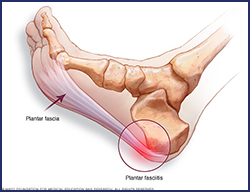Heel Pain Treatment: What You Need to Know
Body
Heel pain is a common problem. People from every age group tend to search for an effective heel pain treatment. Before you try to treat your condition on your own, it is best to understand what exactly is causing the discomfort and which treatment is suitable.
Sometimes, adequate rest can do wonders for your heel pain, and some conditions even lead to surgical intervention.
There are several common causes of heel pain.Certain underlying medical conditions can make the situation worse. Therefore, it is important to make the correct diagnosis in a timely manner to avoid things getting out of control.

Overuse is the common cause of heel pain. Resting is enough for such discomfort, and it doesn’t need a specific treatment. However, if you observe that the pain is not subsiding even after rest, you must consult with a specialist.
For a thorough assessment and suitable treatment, it is best to schedule an appointment with a foot doctor.
What causes heel pain?
Heel problems can affect every age group. However, studies suggest that middle-aged men and women or people who are on their feet for a longer time are at increased risk of heel pain.
Your body weight, lifestyle, age, and plenty of other factors contribute to the problem. The most common reasons for heel pain are listed below.
Plantar fasciitis
Planning to do a room makeover on your own? It’s fun to decorate your home before the holiday season, but standing on the ladder for long hours to paint the entire home can result in an excruciating condition called plantar fasciitis.
The condition can be described by painful and stiff plantar fascia, which is a band of tissue connecting your heel bone to the base of your toes.
When you put too much pressure on the plantar fascia, it gets inflamed and results in a sharp pain in the bottom of the feet, near the heel.
Sprains, strains, and fractures
Apart from overuse discomfort, sometimes physical activities lead to injuries. Some sprains are minor, and in the case of fractures, emergency medical treatment is required. You might even need foot and ankle surgery.
Other conditions
There are many other common problems, like inflamed tendons, bursitis, arthritis, and bone growth disorders,which result in debilitating heel pain.
If overuse injury is not the culprit, talking to a foot doctor is a wise decision. You should consult a doctor for the following conditions:
- When the pain doesn’t subside after a couple of days
- When you can’t walk because ofheel pain
- When you observe redness and swelling around the heel region
How to treat heel pain?
Rest and ice packs are often suggested to minimize the discomfort caused by foot and ankle pain.
Some people even take over the counter painkillers to get a good sleep. These home care strategies only work in mild cases of heel pain. If these don’t work the way you expected, you can try changing your footwear. You can also find relief through night splints and shoe inserts.
Custom orthotics are excellentat providing the necessary support to your feet anatomy. However, a thorough analysis of your foot condition is essential to get the best results. Therefore, it is suggested to consult with a podiatrist and get personalized footwear and orthoticrecommendations.
What are your treatment choices for heel pain?
No need to get scared about heel pain treatment.Not every patient undergoes surgical treatment. Consult with a foot doctor to improve your quality of life.
When you book an appointment with a podiatrist, they will assess your heel pain. Here is how they do it:
- Physical exam
- Assessment of symptoms
- X-ray imaging
- Biomechanical assessment
- Medical history
Podiatrists are foot specialists. They can assess your condition thoroughly to come up with appropriate treatment. Below are some of the treatment choices recommended for heel pain conditions.
- Anti-inflammatory medicines:Heel inflammation can last for several weeks, so your doctor can prescribe suitable drugs to relieve the discomfort. Resist the urge to take such pills on your own because long term usage is linked with certain sideeffects.
- Physical therapy:Pills and injections are great for instant relief, though the permanent solution to your heel pain problems can be found in physical therapy.
Rehabis great for those who are suffering from plantar fasciitis and Achilles tendonitis.
- Orthotics:Conditions like heel spurs and plantar fasciitis are best addressed with custom orthotics. These devices immediately provide relief from heel pain. The treatment option is especially successful when you consult a foot doctor. Since orthotics are made on an individual basis, a proper assessment of the foot condition is important to find the best suited solution.
- Foot and ankle surgery: Surgical recommendations are rare. Doctors only recommend foot and ankle surgery if it is considered necessary for your condition. The surgery is mostly performed as an outpatient procedure.Foot and ankle surgeries can take up to six weeks of recovery time if it is done for plantar fascia, whereas heel spur surgery treatments take longer to recover. Loss of motion is expected in the beginning, but with the right care and professional support, you can get rid of the excruciating heel pain.
Are there any risk factors associated with heel pain?
Heel pain is not just bad for your daily movements and sleepquality, but it can also lead to severe injuries and disorders.
Pain is a warning signal; you should not avoid it. It is highly recommended to treat with suitable medical interventions before your heel pain leads to severe structural damage.
Conclusion
Rest and stretching are the best treatments for heel pain.However, if the discomfort is affecting your range of motion and quality of life, consult a podiatrist.
Book an appointment with board-certified podiatrists at Orange County Foot & Ankle Group. They offer various heel pain treatments along with specialized pain management techniques.









Comments